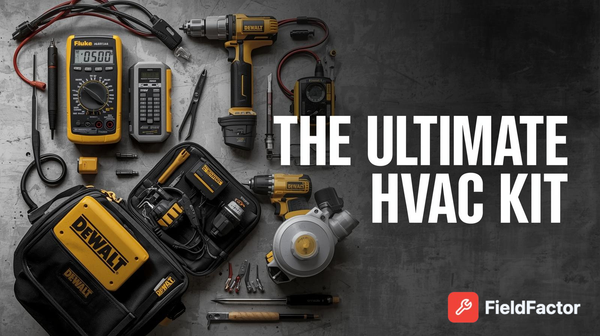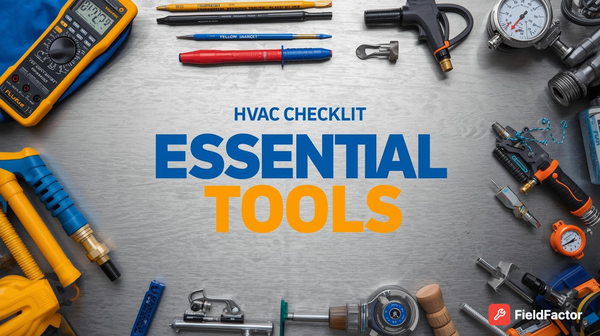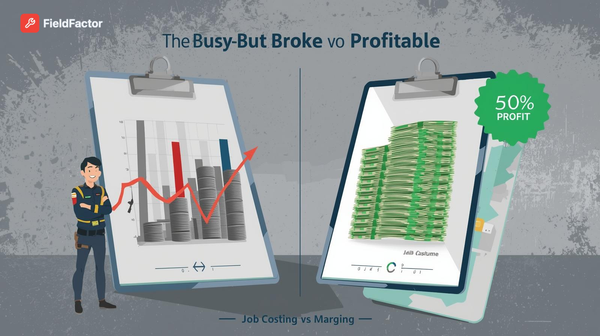HVAC Career in 2025: The Brutal Physical Toll, Burnout, & 4 Hidden Downsides (But Why It's Still Worth $100K)
HVAC tech life is brutal: 2x injury rates, 40% burnout, and seasonal financial stress. But is a $100K salary and recession-proof stability worth the physical toll?

The HVAC industry is a powerhouse: A $69.85 billion U.S. market exploding to $94.71 billion by 2030 at a 6.28% CAGR. This boom is fueled by extreme weather, green retrofits, and a devastating 110,000-technician shortage creating 42,500 annual openings with 6% job growth. Median pay? $59,810, with top 10% techs hitting $91,020+. No degree is needed—just training for entry at $36k-45k, scaling to $70k-$120k mid-career.
Sounds like a dream? For many, it is: Recession-proof stability, hands-on problem-solving, and ownership paths to $100k-$200k. But let's get real: HVAC's glamour hides gritty downsides. From blistering attics and chemical burns to seasonal slumps and a 30-40% burnout-driven turnover, the career's toll is steep. Injury rates are 2x the national average. Drawing from key industry data and social media voices, this guide dives deep into the challenges. We'll quantify the pain, benchmark the risks, and end with why—despite it all—HVAC's rewards make it a resilient, fulfilling path. If you're eyeing the trade or grinding through it, arm yourself with the truth.
The Brutal Body Cost: Why HVAC Injury Rates Are Double the National Average
HVAC isn't desk jockeying—it's climbing ladders, crawling ducts, and wrestling 100-lb units in extreme conditions. The Bureau of Labor Statistics (BLS) ranks HVAC among the top 10 occupations for injuries/illnesses, with rates 2x the national average (3.5 per 100 workers vs. 2.7). This physical toll leads to 25,000+ annual claims from hazards like electrical burns, strains from heavy lifts, and cuts from sharp metal fins.
Deep Dive: The Top 4 HVAC Injuries and the True Cost of Long-Term Pain
| Injury Type | Frequency (Per 100 Workers) | Avg. Claim Cost | Long-Term Impact |
| Strains/Sprains (Back/Shoulder) | 1.8 (Top Cause) | $40,000 | 20% Early Retirement |
| Burns (Electrical/Chemical) | 0.9 | $25,000 | Scarring, Nerve Damage |
| Cuts/Abrasions (Fins/Ducts) | 0.7 | $10,000 | Infection Risk |
| Falls (Ladders/Roofs) | 0.5 | $50,000 | Fractures, Disability |
The Reality: 20% of techs retire early due to musculoskeletal disorders. While unions cut safety violations by 34%, the non-union market (80% of the industry) often lags.
The Financial Anxiety of HVAC: Navigating the Boom-Bust Cycles and Seasonal Slumps
HVAC is weather-tied: Summer AC surges (+50% calls) bury you in 100°F heat, while winter furnace lulls starve cash flow (20-30% revenue dip). This unevenness means 70% of firms struggle with payroll stability. Entry techs ($36k-45k) feel this hardest, with potential income dips of up to $1.5k/month in the off-season.
Seasonality Quantified: How Peak/Valley Work Shifts Can Starve Your Cash Flow
| Season | Call Volume Change | Avg. Hours/Week | Stress Factor |
| Summer (AC Peak) | +50% | 50-60 | High: Burnout, Heat Exhaustion |
| Winter (Furnace) | +20-30% | 40-50 | Med: OT Fatigue |
| Spring/Fall (Maintenance) | -20% | 30-40 | High: Financial Anxiety ($1.5k dip) |
The constant feast/famine cycle erodes confidence. 70% of owners cite seasonality as their top stressor.
The Technician Shortage Crisis: Overwork and the Burnout-Driven 40% Turnover Rate
The 110,000 vacancies mean technicians are juggling 20% more calls, with 25,000 retiring yearly. This overwork is the primary driver of high turnover: 30-40% annually. This instability costs firms $5k-$10k per technician to replace. While 40% of the current workforce is over age 45, Gen Z shuns trades, resulting in 20% fewer new entrants.
The Vicious Cycle: How Understaffing Kills Productivity and Drives Up Costs
| Issue | Impact on Techs | Annual Cost/Firms | Burnout Stat |
| Overwork | 50+ hrs/week peaks | 20% productivity drop | "No life, quit after 2 yrs." |
| Turnover | 30-40% per year | $5k-$10k/tech cost | 64% of techs/owners stressed. |
| Hiring Struggle | Turning away work | $250k/year lost | Shortage killing business. |
Low Start, Slow Climb: The Reality of $36K Entry Pay and the 50% Dropout Rate
Entry-level pay is $36k-$45k ($18-22/hr), which often lags median wages—frustrating for new techs facing high costs of living. Apprenticeships (3-5 years) require 144+ classroom hours/year, delaying the climb to the $70k mid-career level. The tough grind is reflected in the high 50% dropout rate for apprentices.
Paycheck Reality Check: Mapping the HVAC Ladder to the $100K+ Specialist Level
| Level | Avg. Salary Range | Years to Reach | Major Challenge |
| Entry/Apprentice | $36k-$45k | 0-2 | 50% Dropout Rate |
| Mid/Journeyman | $70k-$90k | 3-5 | OT Grind / Cert Costs |
| Senior/Owner | $90k-$120k+ | 5-10 | Ownership Risk |
The Emotional Toll: Dealing with Irate Customers and 2 A.M. Emergency Stress
The majority of service calls (72%) are emergencies. Technicians face irate homeowners yelling about "no AC in 95°F" at 2 AM. 55% of negative reviews are due to delays, and 40% of techs report stress from "unrealistic expectations." The human side of the job contributes significantly to the overall 30-40% burnout rate.
The Unstoppable Upside: Why HVAC's Financial Stability and $100K Potential Outweigh the Grind
The grind is real—physical scars, seasonal stress, and emotional weight—but HVAC's upside shines brighter.
- Growth: 6% job growth outpaces the average, with shortages driving 4-6% pay hikes and $100k+ for specialists.
- Low Debt: Virtually no debt (vs. $30k college costs).
- Stability: The job is recession-proof.
- Protection: Unionization cuts risks by 34%.
- Innovation: AI tools ease burdens, and the shift to green tech (heat pumps) adds $10k-$20k in premium services.
The rewards—financial freedom, hands-on satisfaction, and six-figure potential—make HVAC a resilient, fulfilling path.
Conclusion: Embrace the Fire—The HVAC Grind is the Forge for a $100K Champion Career
HVAC's downsides—body-breaking work, boom-bust cycles, shortage stress—will test your mettle. But they pale against the stability, growth, and six-figure potential in a $70B market hungry for you. With 42,500 openings and new tools easing the load, it's not just a job—it's a craft worth the sweat.
Reference List
- BLS OOH HVAC (2025): https://www.bls.gov/ooh/installation-maintenance-and-repair/heating-air-conditioning-and-refrigeration-mechanics-and-installers.htm
- Workyard HVAC Facts (Sep 4, 2025): https://www.workyard.com/construction-management/hvac-facts-statistics
- ServiceTitan HVAC Stats (Apr 22, 2025): https://www.servicetitan.com/blog/hvac-statistics
- Ellie Marshall Hiring (Sep 16, 2025): https://coachelliemarshall.com/blog/hvac-technician-hiring-strategies-2025
- HVAC Webmasters Stats (Jan 10, 2025): https://www.hvacwebmasters.com/hvac-industry-statistics/
- RightTek Growth (Jun 23, 2025): https://righttekhvac.com/2025/06/23/hvac-career-growth-from-2025-hvac-industry-changes/
- Genesis Career Outlook: https://www.genesiscareer.edu/hvac-job-outlook-career-choice-2025/
- ServiceTitan Job Outlook (Nov 1, 2023, updated 2025): https://www.servicetitan.com/blog/hvac-job-outlook
- NEIT Good Career (May 25, 2021, relevant 2025): https://www.neit.edu/blog/is-hvac-a-good-career
- YouTube "Top 5 Reasons Sucks" (Sep 9, 2025): https://www.youtube.com/watch?v=ciCCcQFwwYQ





